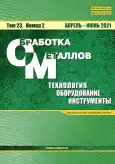Статья содержит обзор исследований, связанных с разработкой, анализом структуры и свойств высокоэнтропийных сплавов (ВЭС). Разработка сплавов на основе энтропийного подхода. Ожидания и современные представления. Отражены заложенные первоначально принципы создания многокомпонентных сплавов, характеризующихся стабильностью структуры и механических свойств. Отмечено, что представления о роли высокой энтропии смешения в формировании неупорядоченных твердых растворов замещения и подавлении охрупчивающих интерметаллидных фаз со временем были существенно изменены. Полагают, что получение однофазной структуры твердого раствора в настоящее время не является обязательным требованием к разрабатываемым ВЭС. Состав высокоэнтропийных сплавов. Отражены примеры разработанных многокомпонентных сплавов различного состава. Отмечается, что одними из наиболее изученных в настоящее время являются сплавы на основе 3-d переходных элементов. На примере сплавов этой группы показана возможность обеспечения как высоких, так и низких значений показателей прочности и пластичности. Методы получения высокоэнтропийных сплавов. Перечислены методы получения высокоэнтропийных сплавов. Отмечается, что чаще всего используют методы, основанные на плавлении исходных материалов и последующей их кристаллизации. Приведены примеры работ, в которых использованы технические решения, основанные на методах порошковой металлургии, магнетронного распыления мишеней, самораспространяющегося высокотемпературного синтеза, спиннингования, диффузионной сварки. Структура высокоэнтропийных сплавов. Приведены сведения о высокоэнтропийных сплавах, характеризующихся многофазным строением, присутствием мелкодисперсных, в том числе наноразмерных выделений. Отмечены работы, в которых высокоэнтропийные сплавы были получены в виде металлических стекол, металлоподобных соединений, карбидов, оксидов, боридов. Представлены результаты анализа ряда факторов, которые по мнению исследователей способны влиять на структурное состояние создаваемых многокомпонентных сплавов. Отмечается неоднозначность суждений, сформулированных различными группами специалистов. Свойства высокоэнтропийных сплавов. Пластическая деформация ВЭС. Приведены работы по изменению структуры и свойств ВЭС методами термопластического воздействия. Методы изучения высокоэнтропийных сплавов. Представлен перечень методов исследования, наиболее часто используемых при работе с ВЭС. Для структурных исследований используют методы просвечивающей и сканирующей электронной микроскопии, рентгеноспектрального анализа, световой микроскопии. Дан краткий анализ подходов к оценке свойств сплавов. Назначение высокоэнтропийных сплавов. Описаны перспективные области применения ВЭС. Отмечается возможность использования сплавов в ракетно-космической отрасли, самолето- и машиностроении, атомной энергетике, устройствах СВЧ, акустоэлектронике. Русскоязычные публикации в области ВЭС. Даны ссылки на публикации отечественных специалистов. Отмечены диссертационные работы, выполненные в российских научных и образовательных организациях.
 6-16
6-16


 17-30
17-30


 31-39
31-39


 40-53
40-53


 54-65
54-65


 66-80
66-80


 81-97
81-97


 98-115
98-115


 116-146
116-146


 147-162
147-162








